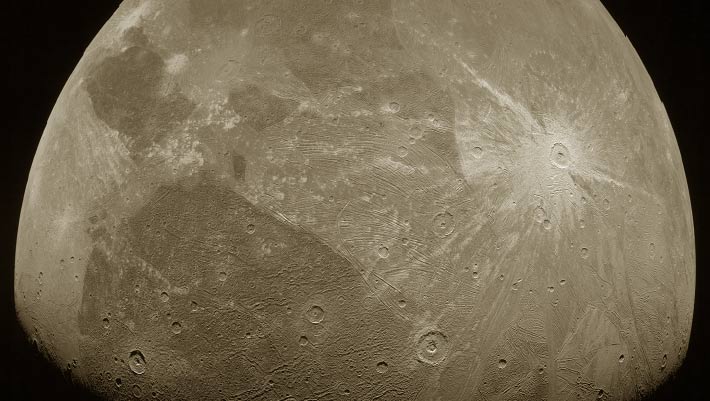Using data from the Jovian InfraRed Auroral Mapper (JIRAM) aboard NASA’s Juno spacecraft, planetary scientists have detected hydrated sodium chloride, ammonium chloride and sodium/ammonium carbonate, as well as organic compounds on the surface of Jupiter’s moon Ganymede.
This image of Ganymede was captured by NASA’s Juno mission during a close flyby in June 2021. The enhanced-color version of the image was created by citizen scientist Thomas Thomopoulos. Image credit: NASA / JPL-Caltech / SwRI / MSSS / Thomas Thomopoulos.
The surface composition of icy satellites, beyond the ubiquitous presence of water ice, is an outstanding question with important implications.
The composition can provide clues to the origin and evolution of the body, and thus may set the stage for habitability.
Subsurface liquid water oceans, when present, may interact with the icy surfaces above, directly bearing on ocean habitability and detection of possible tracers of extraterrestrial life.
Ganymede, the biggest of Jupiter’s moons, has long been of great interest to planetary scientists due to the vast subsurface ocean.
Previous spectroscopic observations by NASA’s Galileo spacecraft and the NASA/ESA Hubble Space Telescope as well as ESO’s Very Large Telescope hinted at the presence of salts and organics, but the spatial resolution of those observations was too low to make a determination.
On June 7, 2021, Juno flew over Ganymede at a minimum altitude of 1,046 km (650 miles).
Shortly after the time of closest approach, the JIRAM instrument acquired infrared images and infrared spectra of the moon’s surface.
JIRAM was designed to capture the infrared light (invisible to the naked eye) that emerges from deep inside Jupiter, probing the weather layer down to 50 to 70 km (30-45 miles) below the gas giant’s cloud tops.
But the instrument has also been used to offer insights into the terrain of moons Io, Europa, Ganymede, and Callisto.
The JIRAM data of Ganymede obtained during the flyby achieved an unprecedented spatial resolution for infrared spectroscopy — better than 1 km (0.62 miles) per pixel.
With it, the Juno scientists were able to detect and analyze the unique spectral features of non-water-ice materials, including hydrated sodium chloride, ammonium chloride, sodium bicarbonate, and possibly aliphatic aldehydes.
“The presence of ammoniated salts suggests that Ganymede may have accumulated materials cold enough to condense ammonia during its formation,” said Dr. Federico Tosi, a Juno co-investigator from Italy’s National Institute for Astrophysics.
“The carbonate salts could be remnants of carbon dioxide-rich ices.”
Previous modeling of Ganymede’s magnetic field determined the moon’s equatorial region, up to a latitude of about 40 degrees, is shielded from the energetic electron and heavy ion bombardment created by Jupiter’s hellish magnetic field.
The presence of such particle fluxes is well known to negatively impact salts and organics.
During the June 2021 flyby, JIRAM covered a narrow range of latitudes (10 degrees north to 30 degrees north) and a broader range of longitudes (minus 35 degrees east to 40 degrees east) in the Jupiter-facing hemisphere.
“We found the greatest abundance of salts and organics in the dark and bright terrains at latitudes protected by the magnetic field,” said Dr. Scott Bolton, Juno’s principal investigator at the Southwest Research Institute.
“This suggests we are seeing the remnants of a deep ocean brine that reached the surface of this frozen world.”
The findings were published in the journal Nature Astronomy.
_____
F. Tosi et al. Salts and organics on Ganymede’s surface observed by the JIRAM spectrometer onboard Juno. Nat Astron, published online October 30, 2023; doi: 10.1038/s41550-023-02107-5




